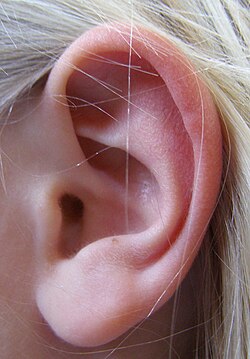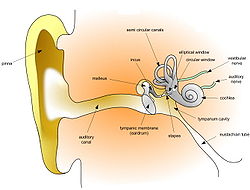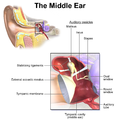Ear

The ear is the part of the body which allows animals (including people) to hear. People and most mammals have ears. Non-mammals, such as lizards or frogs, can also hear, but may have holes instead of external ears. The ear works by directing sound waves to the inner ear. These vibrations are sent to the brain by an organized group of nerves. This system is called the auditory system — auditory meaning relating to hearing and how we hear. The ear is self-cleaning. It uses muscles (such as when the person is chewing or talking) and part of the head or face to push earwax like a "conveyor belt" out of the ear, to the outer ear.
The inner ear is in most vertebrates, but mammals have special adaptations for hearing which even other land vertebrates do not have. These include the external ear and the three little bones which transmit sounds to the brain (the ossicles). The part of the ear that sticks out and can be seen is called the pinna.
Ears are also used in other ways. African elephants use their large ears to cool themselves when it is very hot. Bats rely on their ears to find prey by echolocation. Some animals use their ears for signalling (sending messages) to each other.
Other hearing
In ordinary language, "ear" refers to this receptor which conducts sound and sends signals to the brain. It does not refer to the many other methods of hearing found in fish and invertebrates. Many animals do not hear through ears. Spiders have small hairs on their legs that they can hear with.
Ear Media
"Ear" pronounced (Received Pronunciation) This animated video illustrates how sounds travel to the inner ear, and then to the brain, where they are interpreted and understood. The cochlea in the inner ear is a spiral-shaped organ that contains hair cells, which sense sound vibrations. Hair cells convert sound vibrations into chemical signals that the auditory nerve can understand.
The outer ear receives sound, transmitted through the ossicles of the middle ear to the inner ear, where it is converted to a nervous signal in the cochlear and transmitted along the vestibulocochlear nerve.
The otic placode on a developing embryo (about four weeks old)
The ear develops in the lower neck region and moves upwards as the mandible develops (six weeks).
Primate earsHuman and crab-eating macaque(Darwin's tubercle highlighted) Pinnae of bats
Related pages
+{{{1}}}−{{{2}}}
| Wikimedia Commons has media related to Lua error in Module:Commons_link at line 62: attempt to index field 'wikibase' (a nil value).. |








